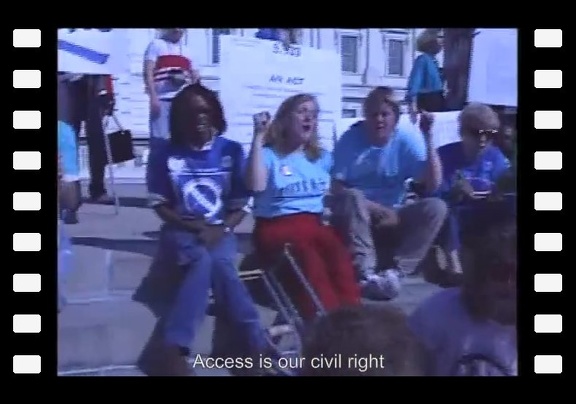504 SIT-INS (1977)
Prior to the passage of the ADA in 1990, section 504 of the Rehabilitation Act of 1973 was meant to prevent discrimination against people with disabilities, and was itself the result of 1972 protests against President Nixon's refusal to sign earlier versions of the law. However, Section 504 could not be enforced without written regulations, and lawmakers delayed doing so for years.
In April 1977, after the Carter administration officials failed to finally sign off on regulations, the American Coalition of Citizens with Disabilities organized sit-ins in the regional offices of the U.S. Department of Health, Education and Welfare, including Washington D.C.
The sit-in in the San Francisco office, co-organized by Judith Heumann, proved the most effective, and lasted for 25 days. Along with the many disabled protesters, the San Francisco sit-in was also notable for the help protesters received from many other civil rights organizations of the area, including the Black Panther party.

GANG OF 19 PUBLIC TRANSIT PROTEST (1978)
In July 1978, to protest the lack of accessibility in Denver's public transit system, disability rights activists from the Atlantis Community and its political arm ADAPT stopped their wheelchairs or lay down on the street around a Denver municipal bus to immobilize it. Led by Atlantis co-founder Wade Blank, the nineteen activists stayed there for the next 24 hours.
This protest was done in support of a lawsuit by the Atlantis Community against the city. The Denver municipal transit authority, known as the Regional Transportation District, agreed soon after to settle the lawsuit and make one-third of the city's buses wheelchair-accessible.
Colorado Experience (PBS): "The Gang of 19 - ADA Movement" (Season 5, episode 14; 2018)
GALLAUDET DEAF PRESIDENT NOW! (1988)
In March 1988, Gallaudet students pushed back against the lack of Deaf leadership in the Deaf President Now protests, which led to the school's first Deaf president.
Deaf Mosaic 402: Deaf President Now (1988; via Gallaudet University)
"Deaf Mosaic", a Gallaudet news program, covered the Deaf President Now movement and was "produced immediately following the events during March 1988." Includes interviews with student leaders and others.
CAPITOL CRAWL & PASSAGE OF THE ADA (1990)
In March 1990, protests over the delay in passing the ADA led to a march on the U.S. Capitol organized by ADAPT. This group included children and adults. Once at the base of the building, many abandoned their wheelchairs and other mobility aids and began crawling up the steps.
The following day, another ADAPT group led a sit-in of the Capitol rotunda.
The ADA was passed and signed into law in July 1990.


"The ADA is a civil rights law that prohibits discrimination against individuals with disabilities in many areas of public life, including jobs, schools, transportation, and many public and private places that are open to the general public. The purpose of the law is to make sure that people with disabilities have the same rights and opportunities as everyone else."
(ADA National Network)
The ADA was passed in July 1990 and expanded upon in 2008 with the Americans with Disabilities Act Amendments Act (ADAAA).
